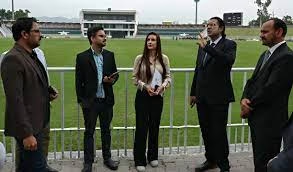In a surprising twist at the PGA Championship, Rory McIlroy was compelled to switch to a backup driver after his regular club was tested and found to be nonconforming, according to a report on SiriusXM PGA Tour Radio.
The equipment issue came to light upon McIlroy’s arrival at Quail Hollow Club, where routine club inspections are conducted ahead of major tournaments. The United States Golf Association (USGA), which handles compliance testing at the request of U.S. tournaments, confirmed it performed driver testing on-site prior to the championship’s opening round.
While the USGA did not name specific players or results, the PGA Tour Radio report revealed that McIlroy’s go-to driver failed to meet the established standards, forcing the four-time major winner to make an unexpected equipment change — a disruption that may have played a role in his uncharacteristic performance off the tee.
McIlroy’s struggles were evident through the first two rounds of the championship. Among the 74 players who made the cut, he ranked last in driving accuracy, managing to hit only 10 fairways across 36 holes. His second round ended with a bogey on the 18th hole after a wayward tee shot veered left, flying over a creek and into a hospitality area near the corporate tents.
Despite the commotion and speculation surrounding the equipment controversy, McIlroy declined to speak to the media after each of his first two rounds — an unusual move for the reigning Masters champion, who is typically more open with reporters even during tough tournaments.
Testing and Transparency
When asked about the testing protocols, the USGA issued a statement explaining its role in ensuring clubs used in competition adhere to the rules of golf.
That program is consistent with the same level of support that we provide to the PGA Tour as part of their regular program for driver testing,the USGA stated.
All testing is conducted prior to the start of the first round, and results — including which clubs were tested and the outcomes — are kept confidential.
The PGA of America, which oversees the PGA Championship, has yet to release any details about how many players had clubs tested or whether any other drivers failed to meet specifications. Inquiries regarding specifics were directed back to the USGA’s blanket statement.
A Critical Time for McIlroy
The timing of the equipment issue could not have been worse for McIlroy, who entered the PGA Championship riding high after winning The Masters and aiming to continue his career Grand Slam bid. Many saw Quail Hollow — where McIlroy has enjoyed past success — as a venue well-suited for his strengths. However, losing confidence in his driver just days before teeing off appears to have impacted his rhythm and accuracy.
It remains unclear what exact aspect of the driver was found to be nonconforming. Driver heads can fail testing if their spring-like effect (CT — characteristic time) exceeds the legal limit, which would provide an unfair distance advantage.
No Formal Accusations or Penalties
It’s important to note that equipment testing is not a punitive process, and nonconforming drivers discovered during pre-round checks do not result in penalties. The goal is to ensure a level playing field before competition begins.
Still, switching to a backup driver with little time to adapt can be unsettling for players at the highest level, particularly those as reliant on driving performance as McIlroy.
McIlroy’s ability to make the cut — barely — despite the setback is a testament to his resilience. Whether he can recover and climb the leaderboard over the weekend remains to be seen. His fans and the golfing world will no doubt be watching closely to see if he can regain composure and adjust to the sudden change in equipment.
While the PGA Championship continues, the incident raises larger questions about transparency in equipment testing, and whether more details should be shared with the public — especially when such findings potentially affect the performance of high-profile players.



